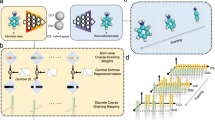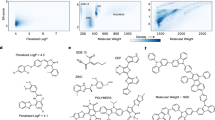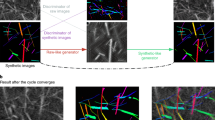Abstract
Sampling from known probability distributions is a ubiquitous task in computational science, underlying calculations in domains from linguistics to biology and physics. Generative machine-learning (ML) models have emerged as a promising tool in this space, building on the success of this approach in applications such as image, text and audio generation. Often, however, generative tasks in scientific domains have unique structures and features — such as complex symmetries and the requirement of exactness guarantees — that present both challenges and opportunities for ML. This Perspective outlines the advances in ML-based sampling motivated by lattice quantum field theory, in particular for the theory of quantum chromodynamics. Enabling calculations of the structure and interactions of matter from our most fundamental understanding of particle physics, lattice quantum chromodynamics is one of the main consumers of open-science supercomputing worldwide. The design of ML algorithms for this application faces profound challenges, including the necessity of scaling custom ML architectures to the largest supercomputers, but also promises immense benefits, and is spurring a wave of development in ML-based sampling more broadly. In lattice field theory, if this approach can realize its early promise it will be a transformative step towards first-principles physics calculations in particle, nuclear and condensed matter physics that are intractable with traditional approaches.
This is a preview of subscription content, access via your institution
Access options
Access Nature and 54 other Nature Portfolio journals
Get Nature+, our best-value online-access subscription
$29.99 / 30 days
cancel any time
Subscribe to this journal
Receive 12 digital issues and online access to articles
$99.00 per year
only $8.25 per issue
Buy this article
- Purchase on Springer Link
- Instant access to full article PDF
Prices may be subject to local taxes which are calculated during checkout




Similar content being viewed by others
References
Borsanyi, S. et al. Ab initio calculation of the neutron–proton mass difference. Science 347, 1452–1455 (2015).
Brown, Z. S., Detmold, W., Meinel, S. & Orginos, K. Charmed bottom baryon spectroscopy from lattice QCD. Phys. Rev. D 90, 094507 (2014).
Aaij, R. et al. Observation of two new \({\Xi }_{b}^{-}\) baryon resonances. Phys. Rev. Lett. 114, 062004 (2015).
Aaij, R. et al. Observation of the doubly charmed baryon \({\Xi }_{cc}^{++}\). Phys. Rev. Lett. 119, 112001 (2017).
Joó, B. et al. Status and future perspectives for lattice gauge theory calculations to the exascale and beyond. Eur. Phys. J. A 55, 199 (2019).
Detmold, W. et al. Hadrons and nuclei. Eur. Phys. J. A 55, 193 (2019).
Calì, S., Hackett, D. C., Lin, Y., Shanahan, P. E. & Xiao, B. Neural-network preconditioners for solving the Dirac equation in lattice gauge theory. Phys. Rev. D 107, 034508 (2023).
Lehner, C. & Wettig, T. Gauge-equivariant pooling layers for preconditioners in lattice QCD. Preprint at https://arxiv.org/abs/2304.10438 (2023).
Lehner, C. & Wettig, T. Gauge-equivariant neural networks as preconditioners in lattice QCD. Preprint at https://arxiv.org/abs/2302.05419 (2023).
Metropolis, N., Rosenbluth, A. W., Rosenbluth, M. N., Teller, A. H. & Teller, E. Equation of state calculations by fast computing machines. J. Chem. Phys. 21, 1087–1092 (1953).
Duane, S., Kennedy, A. D., Pendleton, B. J. & Roweth, D. Hybrid Monte Carlo. Phys. Lett. B 195, 216–222 (1987).
Chen, D. et al. QCDOC: a 10-teraflops scale computer for lattice QCD. Nucl. Phys. B Proc. Suppl. 94, 825–832 (2001).
Jumper, J. et al. Highly accurate protein structure prediction with AlphaFold. Nature 596, 583–589 (2021).
Hoffmann, J. et al. Training compute-optimal large language models. Preprint at https://arxiv.org/abs/2203.15556 (2022).
Thoppilan, R. et al. Lamda: Language models for dialog applications. Preprint at https://arxiv.org/abs/2201.08239 (2022).
Peskin, M. E. & Schroeder, D. V. An Introduction to Quantum Field Theory (Addison-Wesley, 1995).
Berezin, F. A. The method of second quantization. Pure Appl. Phys. 24, 1–228 (1966).
Gattringer, C. & Lang, C. B. Quantum Chromodynamics on the Lattice Vol. 788 (Springer, 2010).
Hastings, W. K. Monte Carlo sampling methods using Markov chains and their applications. Biometrika 57, 97–109 (1970).
Schaefer, S., Sommer, R. & Virotta, F. Critical slowing down and error analysis in lattice QCD simulations. Nucl. Phys. B 845, 93–119 (2011).
Beck, C., Hutzenthaler, M., Jentzen, A. & Kuckuck, B. An overview on deep learning-based approximation methods for partial differential equations. Discrete Contin. Dyn. Syst. B 28, 3697–3746 (2023).
Oord, A. v. d. et al. Wavenet: a generative model for raw audio. Preprint at https://arxiv.org/abs/1609.03499 (2016).
Dhariwal, P. & Nichol, A. Diffusion models beat GANs on image synthesis. Adv. Neural Inf. Process. Syst. 34, 8780–8794 (2021).
Saharia, C. et al. Photorealistic text-to-image diffusion models with deep language understanding. Adv. Neural Inf. Process. Syst. 35, 36479–36494 (2022).
Child, R. Very deep VAEs generalize autoregressive models and can outperform them on images. Preprint at https://arxiv.org/abs/2011.10650 (2020).
Kaplan, J. et al. Scaling laws for neural language models. Preprint at https://arxiv.org/abs/2001.08361 (2020).
Brown, T. et al. Language models are few-shot learners. Adv. Neural Inf. Process. Syst. 33, 1877–1901 (2020).
Lieber, O., Sharir, O., Lenz, B. & Shoham, Y. Jurassic-1: Technical Details and Evaluation White Paper (AI21 Labs, 2021).
Rae, J. W. et al. Scaling language models: methods, analysis & insights from training gopher. Preprint at https://arxiv.org/abs/2112.11446 (2021).
Smith, S. et al. Using DeepSpeed and Megatron to train Megatron-Turing NLG 530B, a large-scale generative language model. Preprint at https://arxiv.org/abs/2201.11990 (2022).
Kullback, S. & Leibler, R. A. On information and sufficiency. Ann. Math. Stat. 22, 79–86 (1951).
Goodfellow, I. et al. Generative adversarial nets. Adv. Neural Inf. Process. Syst. 27, 2672–2680 (2014).
Rezende, D. J., Mohamed, S. & Wierstra, D. Stochastic backpropagation and approximate inference in deep generative models. Proceedings of Machine Learning Research 32(2), 1278–1286 (2014).
Kingma, D. P. & Welling, M. Auto-encoding variational Bayes. Preprint at https://arxiv.org/abs/1312.6114 (2014).
Van Oord, A., Kalchbrenner, N. & Kavukcuoglu, K. Pixel recurrent neural networks. Proceedings of Machine Learning Research 48, 1747–1756 (2016).
Chen, C. et al. Continuous-time flows for efficient inference and density estimation. Proceedings of Machine Learning Research 80, 824–833 (2018).
Chen, R. T. & Duvenaud, D. K. Neural networks with cheap differential operators. Adv. Neural Inf. Process. Syst. 32, 9961–9971 (2019).
Papamakarios, G., Nalisnick, E. T., Rezende, D. J., Mohamed, S. & Lakshminarayanan, B. Normalizing flows for probabilistic modeling and inference. J. Mach. Learn. Res. 22, 1–64 (2021).
Rezende, D. & Mohamed, S. Variational inference with normalizing flows. Proceedings of Machine Learning Research 37, 1530–1538 (2015).
Tabak, E. G. & Turner, C. V. A family of nonparametric density estimation algorithms. Commun. Pure Appl. Math. 66, 145–164 (2013).
Dinh, L., Sohl-Dickstein, J. & Bengio, S. Density estimation using real NVP. In International Conference on Learning Representations (ICLR, 2017).
Kingma, D. P. & Dhariwal, P. Glow: generative flow with invertible 1x1 convolutions. Adv. Neural Inf. Process. Syst. 31, 10215–10224 (2018).
Papamakarios, G., Pavlakou, T. & Murray, I. Masked autoregressive flow for density estimation. Adv. Neural Inf. Process. Syst. 30, 2338–2347 (2017).
Huang, C.-W., Dinh, L. & Courville, A. Augmented normalizing flows: bridging the gap between generative flows and latent variable models. Preprint at https://arxiv.org/abs/2002.07101 (2020).
Laszkiewicz, M., Lederer, J. & Fischer, A. Marginal tail-adaptive normalizing flows. Proceedings of Machine Learning Research 162, 12020–12048 (2022).
Wu, H., Köhler, J. & Noé, F. Stochastic normalizing flows. Adv. Neural Inf. Process. Syst. 33, 5933–5944 (2020).
Müller, T., McWilliams, B., Rousselle, F., Gross, M. & Novák, J. Neural importance sampling. ACM Trans. Graph. 38, 1–19 (2019).
Robert, C. P., Casella, G. & Casella, G. Monte Carlo Statistical Methods Vol. 2 (Springer, 1999).
Hoffman, M. et al. Neutralizing bad geometry in Hamiltonian Monte Carlo using neural transport. Preprint at https://arxiv.org/abs/1903.03704 (2019).
Nijkamp, E. et al. Learning energy-based model with flow-based backbone by neural transport MCMC. Preprint at https://arxiv.org/abs/2006.06897 (2020).
Wang, T., Wu, Y., Moore, D. & Russell, S. J. Meta-learning MCMC proposals. Adv. Neural Inf. Process. Syst. 31, 4146–4156 (2018).
Song, J., Zhao, S. & Ermon, S. A-NICE-MC: adversarial training for MCMC. Adv. Neural Inf. Process. Syst. 30, 5140–5150 (2017).
Li, Z., Chen, Y. & Sommer, F. T. A neural network MCMC sampler that maximizes proposal entropy. Entropy 23, 269 (2021).
Huang, L. & Wang, L. Accelerated Monte Carlo simulations with restricted Boltzmann machines. Phys. Rev. B 95, 035105 (2017).
Liu, J., Qi, Y., Meng, Z. Y. & Fu, L. Self-learning Monte Carlo method. Phys. Rev. B 95, 041101 (2017).
Liu, J., Shen, H., Qi, Y., Meng, Z. Y. & Fu, L. Self-learning Monte Carlo method and cumulative update in fermion systems. Phys. Rev. B 95, 241104 (2017).
Nagai, Y., Shen, H., Qi, Y., Liu, J. & Fu, L. Self-learning Monte Carlo method: continuous-time algorithm. Phys. Rev. B 96, 161102 (2017).
Shen, H., Liu, J. & Fu, L. Self-learning Monte Carlo with deep neural networks. Phys. Rev. B 97, 205140 (2018).
Xu, X. Y., Qi, Y., Liu, J., Fu, L. & Meng, Z. Y. Self-learning quantum Monte Carlo method in interacting fermion systems. Phys. Rev. B 96, 041119 (2017).
Chen, C. et al. Symmetry-enforced self-learning Monte Carlo method applied to the Holstein model. Phys. Rev. B 98, 041102 (2018).
Nagai, Y., Okumura, M. & Tanaka, A. Self-learning Monte Carlo method with Behler–Parrinello neural networks. Phys. Rev. B 101, 115111 (2020).
Nagai, Y., Tanaka, A. & Tomiya, A. Self-learning Monte Carlo for non-Abelian gauge theory with dynamical fermions. Phys. Rev. D 107, 054501 (2023).
Pawlowski, J. M. & Urban, J. M. Reducing autocorrelation times in lattice simulations with generative adversarial networks. Mach. Learn. Sci. Technol. 1, 045011 (2020).
Foreman, S. et al. HMC with normalizing flows. PoS LATTICE2021, 073 (2022).
Arbel, M., Matthews, A. & Doucet, A. Annealed flow transport Monte Carlo. Proceedings of Machine Learning Research 139, 318–330 (2021).
Matthews, A. G. D. G., Arbel, M., Rezende, D. J. & Doucet, A. Continual repeated annealed flow transport Monte Carlo. Proceedings of Machine Learning Research 162, 15196–15219 (2022).
Caselle, M., Cellini, E., Nada, A. & Panero, M. Stochastic normalizing flows as non-equilibrium transformations. J. High Energy Phys. 2022, 1–31 (2022).
Veach, E. & Guibas, L. J. Optimally combining sampling techniques for monte carlo rendering. In Proceedings of the 22nd Annual Conference on Computer Graphics and Interactive Techniques, 419–428 (1995).
Müller, T., Rousselle, F., Keller, A. & Novák, J. Neural control variates. ACM Trans. Graph. 39, 1–19 (2020).
Li, S.-H. & Wang, L. Neural network renormalization group. Phys. Rev. Lett. 121, 260601 (2018).
Li, S.-H., Dong, C.-X., Zhang, L. & Wang, L. Neural canonical transformation with symplectic flows. Phys. Rev. X 10, 021020 (2020).
Tomiya, A. & Nagai, Y. Gauge covariant neural network for 4 dimensional non-Abelian gauge theory. Preprint at https://arxiv.org/abs/2103.11965 (2021).
Tanaka, A. & Tomiya, A. Towards reduction of autocorrelation in HMC by machine learning. Preprint at https://arxiv.org/abs/1712.03893 (2017).
Shorten, C. & Khoshgoftaar, T. M. A survey on image data augmentation for deep learning. J. Big Data 6, 1–48 (2019).
Mitrovic, J., McWilliams, B., Walker, J. C., Buesing, L. H. & Blundell, C. Representation learning via invariant causal mechanisms. In International Conference on Learning Representations (2020).
Rezende, D. J., Racanière, S., Higgins, I. & Toth, P. Equivariant Hamiltonian flows. Preprint at https://arxiv.org/abs/1909.13739 (2019).
Cohen, T. & Welling, M. Group equivariant convolutional networks. Proceedings of Machine Learning Research 48, 2990–2999 (2016).
Fuchs, F., Worrall, D., Fischer, V. & Welling, M. SE(3)-transformers: 3D roto-translation equivariant attention networks. Adv. Neural Inf. Process. Syst. 33, 1970–1981 (2020).
Du, W. et al. SE(3) equivariant graph neural networks with complete local frames. Proceedings of Machine Learning Research 162, 5583–5608 (2022).
Kanwar, G. et al. Equivariant flow-based sampling for lattice gauge theory. Phys. Rev. Lett. 125, 121601 (2020).
Boyda, D. et al. Sampling using SU(N) gauge equivariant flows. Phys. Rev. D 103, 074504 (2021).
Jin, X.-Y. Neural network field transformation and its application in HMC. In The 38th International Symposium on Lattice Field Theory Vol. 396, 600 (PoS, 2022).
Kanwar, G. et al. Equivariant flow-based sampling for lattice gauge theory. Phys. Rev. Lett. 125, 121601 (2020).
Katsman, I. et al. Equivariant manifold flows. Adv. Neural Inf. Process. Syst. 34, 10600–10612 (2021).
Finkenrath, J. Tackling critical slowing down using global correction steps with equivariant flows: the case of the Schwinger model. Preprint at https://arxiv.org/abs/2201.02216 (2022).
de Haan, P., Rainone, C., Cheng, M. & Bondesan, R. Scaling up machine learning for quantum field theory with equivariant continuous flows. Preprint at https://arxiv.org/abs/2110.02673 (2021).
Albergo, M. S. et al. Flow-based sampling for fermionic lattice field theories. Phys. Rev. D 104, 114507 (2021).
Hackett, D. C. et al. Flow-based sampling for multimodal distributions in lattice field theory. Preprint at https://arxiv.org/abs/2107.00734 (2021).
Albergo, M. S., Kanwar, G. & Shanahan, P. E. Flow-based generative models for markov chain monte carlo in lattice field theory. Phys. Rev. D 100, 034515 (2019).
Vaitl, L., Nicoli, K. A., Nakajima, S. & Kessel, P. Path-gradient estimators for continuous normalizing flows. Proceedings of Machine Learning Research, 162, 21945–21959 (2022).
Köhler, J., Klein, L. & Noé, F. Equivariant flows: exact likelihood generative learning for symmetric densities. Proceedings of Machine Learning Research 119, 5361–5370 (2020).
Abbott, R. et al. Gauge-equivariant flow models for sampling in lattice field theories with pseudofermions. Phys. Rev. D 106, 074506 (2022).
Albergo, M. S. et al. Flow-based sampling for fermionic lattice field theories. Phys. Rev. D 104, 114507 (2021).
Abbott, R. et al. Sampling QCD field configurations with gauge-equivariant flow models. In The 39th International Symposium on Lattice Field Theory Vol. 430, 036 (PoS, 2023).
Lüscher, M. Trivializing maps, the Wilson flow and the HMC algorithm. Commun. Math. Phys. 293, 899–919 (2010).
Lüscher, M. & Weisz, P. Perturbative analysis of the gradient flow in non-Abelian gauge theories. J. High Energy Phys. 2011, 1–23 (2011).
Gerdes, M., de Haan, P., Rainone, C., Bondesan, R. & Cheng, M. C. N. Learning lattice quantum field theories with equivariant continuous flows. Preprint at https://arxiv.org/abs/2207.00283 (2022).
Bacchio, S., Kessel, P., Schaefer, S. & Vaitl, L. Learning trivializing gradient flows for lattice gauge theories. Phys. Rev. D 107, L051504 (2023).
Albergo, M. S. et al. Flow-based sampling in the lattice Schwinger model at criticality. Phys. Rev. D 106, 014514 (2022).
Abbott, R. et al. Aspects of scaling and scalability for flow-based sampling of lattice QCD. Preprint at https://arxiv.org/abs/2211.07541 (2022).
Gabbard, H., Messenger, C., Heng, I. S., Tonolini, F. & Murray-Smith, R. Bayesian parameter estimation using conditional variational autoencoders for gravitational-wave astronomy. Nat. Phys. 18, 112–117 (2022).
Musaelian, A. et al. Learning local equivariant representations for large-scale atomistic dynamics. Nat. Commun. 14, 579 (2023).
Singha, A., Chakrabarti, D. & Arora, V. Conditional normalizing flow for Markov chain Monte Carlo sampling in the critical region of lattice field theory. Phys. Rev. D 107, 014512 (2023).
Lehner, C. & Wettig, T. Gauge-equivariant neural networks as preconditioners in lattice QCD. Preprint at https://arxiv.org/abs/2302.05419 (2023).
Sutton, R. The Bitter Lesson (2019); https://www.cs.utexas.edu/~eunsol/courses/data/bitter_lesson.pdf.
Acknowledgements
We thank W. Detmold and R. D. Young for comments on the manuscript. P.E.S. was supported in part by the US Department of Energy, Office of Science, Office of Nuclear Physics, under grant contract number DE-SC0011090, and by Early Career Award DE-SC0021006, by a NEC research award, and by the Carl G. and Shirley Sontheimer Research Fund. G.K. was supported by funding from the Schweizerischer Nationalfonds (grant agreement no. 200020_200424).
Author information
Authors and Affiliations
Contributions
The authors contributed equally to all aspects of the article.
Corresponding author
Ethics declarations
Competing interests
The authors declare no competing interests.
Peer review
Peer review information
Nature Reviews Physics thanks Tanmoy Bhattacharya and the other, anonymous, reviewer(s) for their contribution to the peer review of this work.
Additional information
Publisher’s note Springer Nature remains neutral with regard to jurisdictional claims in published maps and institutional affiliations.
Rights and permissions
Springer Nature or its licensor (e.g. a society or other partner) holds exclusive rights to this article under a publishing agreement with the author(s) or other rightsholder(s); author self-archiving of the accepted manuscript version of this article is solely governed by the terms of such publishing agreement and applicable law.
About this article
Cite this article
Cranmer, K., Kanwar, G., Racanière, S. et al. Advances in machine-learning-based sampling motivated by lattice quantum chromodynamics. Nat Rev Phys 5, 526–535 (2023). https://doi.org/10.1038/s42254-023-00616-w
Accepted:
Published:
Issue Date:
DOI: https://doi.org/10.1038/s42254-023-00616-w




